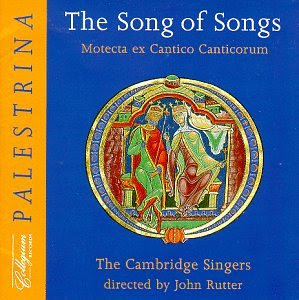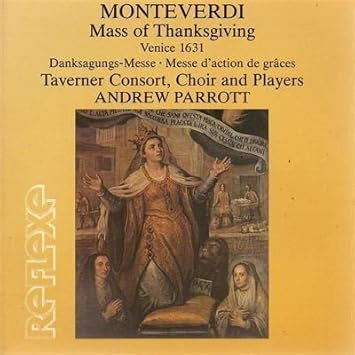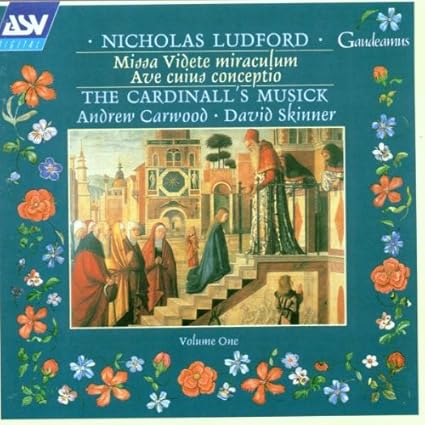Program: #94-22 Air Date: May 30, 1994
This program is Free for all, thanks to this generous Preservation Grant:
I. The Song of Songs (Cambridge Singers/John Rutter). Collegium CD 122

II. The Tallis Scholars Sing Palestrina (Tallis Scholars/Peter Phillips). Gimell CD 204.

III. Palestrina: Missa O sacrum convivium (Choir of Christ Church Cathedral, Oxford/Stephen Darlington). Nimbus CD 5394.

The composer's life was lived mostly in Counter-Reformation Rome; he worked for a large variety of religious foundations and lay patrons and was obviously a force to be reckoned with in his dealings on fees, conditions and which 'commissions' he accepted. His output is large, including over one hundred attributable masses, of which O Sacrum Convivium is only otherwise available in an alternative grouping by this same choir and conductor (on a five disc survey, 'European Choral Music 1525-1751' - Nimbus 1758).
It's a beautiful parody mass using the motet, O Sacrum Convivium, by Cristóbal de Morales (c.1500 – 1553) as its 'source'. From the opening of the Kyrie it's evident that the singers are pledged fully to convey the gentle and somewhat understated nature of the motet. Perhaps it's to make that impact all the greater that the usual practice of placing the motet first in the track order has not been followed … it's to be heard at the very end [tr.10]. Even after the delightful and exhilarating Coenantibus illis [tr. 8] (another Corpus Christi motet) and after the splendid Magnificat (Sexti Toni a 6) [tr.9], which is a heady alternation of chant and polyphony.
These themselves follow Palestrina's own setting [tr.7] of the motet O Sacrum Convivium itself; this builds on the plainsong antiphon, not on Morales' work. Tracks can usually be set to play in any order. But with music as ethereal and sublime as this, one scarcely wants to be fiddling with buttons. The producers of the CD may have had a reason for the order they chose. Here let's assume it was aesthetic contrast, and not reference.
The Mass is a reflective work, as befits the occasion which it celebrates - the feast day of Corpus Christi in early summer. Palestrina adheres closely to Morales' work, opening all of the movements except the Et incarnatus and Crucifixus with the earlier composer's motifs. There is - of course - a close match between Palestrina's musical ideas, especially counterpoint, and the text. The articulation and phrasing of the choir respects this well … listen to the changed tempo two or three minutes into the longest movement, the Credo [tr.3], for example. It almost comes to a complete stop as if to invite, not pressure, us into examining the import of the text.
Not that the Choir's style lacks life or forward movement. Later in the movement their pace is full of the joy surrounding faith. But it's a graceful and considered joy, rather than an unbounded one. Their singing is lucid, clean and forward. In the sympathetic acoustic of Dorchester Abbey, Oxford, this is a CD which meets all its expectations. There is a useful introductory essay and full texts in the accompanying booklet. Even were there another recording for comparison, the style and sense of immediacy tempered with elegance in what is an almost relaxed Mass of these performers make the release one to treasure.
Mark Sealey
Missa O Sacrum Convivium
Missa, 'O Sacrum Convivium' [30:50]
O Sacrum Convivium [5.00]
Coenantibus illis [5.41]
Magnificat (Sexti Toni a 6) [11.48]
Motet, 'O Sacrum Convivium' [4.40]
IV. Palestrina: Missa Papae Marcelli (The Sixteen/Harry Christophers). Collins Classics CD 50092.
:format(jpeg):mode_rgb():quality(90)/discogs-images/R-3606647-1337130645-3746.jpeg.jpg)
Antonio Lotti (1667-1740)
1. Crucifixus
Giovanni Pierluigi da Palestrina (1525-1594)
2. Stabat Mater Dolorosa
Gregorio Allegri (1582-1652)
3. Miserere Mei
Palestrina
Missa Papae Marcelli
4. Kyrie
5. Gloria
6. Credo
7. Sanctus and Benedictus
8. Agnus Dei I
9. Agnus Dei II
Total playing time: 56.26
V. Vespro Della Beata Vergine. Marien-Vesper 1610
:format(jpeg):mode_rgb():quality(40)/discogs-images/R-5216576-1387748866-1144.jpeg.jpg)
- Baritone Vocals – Max Van Egmond
- Bass Vocals – Jacques Villisech
- Bombarde [Piffaro] – Jürg Schaeftlein, Karl Gruber
- Choir – Monteverdi-Chor Hamburg
- Chorus [Antiphonen] – Choralschola Der Capella Antiqua München
- Chorus Master [Capella Antiqua] – Konrad Ruhland
- Composed By – Claudio Monteverdi
- Conductor – Jürgen Jürgens
- Cornett – Albrecht Trenz, Gerhard Stradner
- Cornett [Zink] – Edward Tarr*
- Dulcian – Otto Fleischmann
- Ensemble – Concentus Musicus Wien
- Fiddle [Bass] – Hermann Höbarth
- Fiddle [Tenor] – Nikolaus Harnoncourt
- Harpsichord – Gustav Leonhardt
- Instrumentation By – Nikolaus Harnoncourt
- Liner Notes [Claudio Monteverdi] – Wolfgang Osthoff
- Liner Notes [The Instrumentation] – Nikolaus Harnoncourt
- Liner Notes [The Performance] – Jürgen Jürgens
- Liner Notes [The Structure Of The Vespers] – Konrad Ruhland
- Lute – Gusta Goldschmidt
- Organ – Herbert Tachezi
- Recorder – Bernhard Klebel (2), Helga Tutschek, Jürg Schaeftlein, Leopold Statsny*
- Soprano Vocals [Sopran I] – Rotraud Hansmann
- Soprano Vocals [Sopran Ii] – Irmgard Jacobeit
- Tenor Vocals [Tenor I] – Nigel Rogers (2)
- Tenor Vocals [Tenor Ii] – Bert Van T'Hoff
- Trombone – Andreas Wenth, Ernst Hoffmann (2), Hans Pöttler
- Viol [Tenor] – Elli Kubizek
- Viola [Tenor] – Kurt Theiner
- Violin – Alice Harnoncourt, Josef De Sordi, Peter Schoberwalter, Walter Pfeiffer
- Violone – Eduard Hruza
- Virginal – Gustav Leonhardt
- Vocals – Knabensolisten Der Wiener Sängerknaben*
| A1 | Domine Ad Adiuvandum Me | |
| A2 | Psalm 109: Dixit Dominus | |
| A3 | Concerto: Nigra Sum | |
| A4 | Psalm 112: Laudate Pueri Dominum | |
| A5 | Concerto: Pulchra Es | |
| B1 | Psalm 121: Laetatus Sum | |
| B2 | Concerto: Duo Seraphim | |
| B3 | Psalm 126: Nisi Dominus | |
| B4 | Concerto: Audi Coelum | |
| C1 | Psalm 147: Lauda Jerusalem Dominum | |
| C2 | Hymnus: Ave Maris Stella | |
| C3 | Sonata: Sancta Maria Ora Pro Nobis | |
|
Magnificat |
||
| D1a | Magnificat | |
| D1b | Et Exultavit | |
| D1c | Quia Respexit | |
| D1d | Quia Fecit Mihi Magna | |
| D1e | Et Misericordia | |
| D1f | Fecit Potentiam | |
| D1g | Deposuit Potes De Sede | |
| D1h | Esurientes Implevit Bonis | |
| D1i | Suscepit Israel | |
| D1k | Sicut Iocutus Est | |
| D1l | Gloria Patri | |
| D1m | Sicut Erat In Principio |
|
VI. Monteverdi: Mass of Thanksgiving (Taverner Consort & Players/Andrew Parrott). EMI CD 54886.

This recording represents perhaps the most convincing reconstruction of the musical aspect of a particular liturgical celebration that I have yet come across. There are various reasons for this, not least the fact that we have more evidence than usual for the occasion in question: the date (November 21st, 1631); place (St Mark's Venice); motive (thanksgiving for the delivery of Venice from the plague); music (some of it, like the magnificent seven-part Gloria, indisputedly, while the rest can be restored with educated guesswork); and, last but not least, documentary evidence in the form of accounts—both financial and eyewitness. Beyond all of this, however, is the quality of the performance itself, complete with appropriate sound effects (such as the gentle clanking of the thurible and the crack of fireworks that brings a distinctly authentic southern European Catholic atmosphere). Tastefully deployed, as here, they bring a sense of ceremony and ritual—which must surely be part of any attempt at reconstructing such a solemn, festive event.
On the recording, the atmosphere is heightened by the use of carefully worked-out spatial effects in an attempt to take into consideration the original positioning and movement in St Mark's. It was actually made in a building about as far removed from the splendours of the great Venetian basilica as possible—Abbey Road Studio No. 1—but the space there was clearly large and flexible enough to recreate the idea of distance in the approaching and receding processions framing the Mass, and (though less noticeably) the relative positions of concertato and plainchant choirs, organs and other instruments. Credit must be given to the technicians not only for achieving this sense of movement without disorientating the listener, but also seeking out a rich, clear sound churchy but not muffled—an improvement, it has to be said, on what you would probably have had as a member of the congregation in St Mark's.
The singers of the Taverner Consort and Choir may not all have the most beautiful of voices, but they bring an intensity to the sound that is laudably consistent throughout—it must, after all, have been an emotional occasion. This goes for the chant as much as for the polyphonic and concerted items. The chanting is refreshingly unfussy, direct and masculine—a point reinforced by Parrott's belief that it should not necessarily be performed with tenors and basses entirely in unison so that where it becomes uncomfortably high for the latter they should quite naturally fall down the octave. This makes for a still relatively strange sound to modern ears, but one that is not—and perhaps not coincidentally—without drama. If you thought all chant consisted of long, hopelessly meandering melodies, try the tone for the Gospel: its minimalism (stemming from the text) is extraordinarily hypnotic in effect. I would strongly endorse Parrott's recommendation to resist any temptation to skip the chant tracks, as he points out, the architecture of the whole provides a perhaps surprisingly satisfying musical experience.
The musical centrepiece of the reconstruction is without doubt the Gloria, resplendent with restored trumpet parts, and Parrott musters his forces well to bring out the drama of the contrasted sections: the soloists agile and expressive by turn, the choir incisive, and the instrumental playing superb, particularly from the violins. Yet there are many more goodies, not least Rovetta's Credo setting with its own internal contrasts and strongly melodic appeal (''Deum de Deo, lumen de lumine'' is a particularly lovely moment) and the virtuoso instrumental items, clearly chosen with care from the output of little-known masters such as Scarani, Usper and Fantini.
By their nature reconstructions do not necessarily conform to CD requirements, but even if one-and-a-half hours of music spread over two discs does not give as good value as some, you can be sure of the quality. All in all, this is a very special and enriching recording.
-- Tess Knighton, Gramophone
|
1-1 |
Introitus |
4:02 |
|
1-2 |
Intrada : Toccata & Sonata Imperiale I Composed By – Girolamo Fantini |
3:13 |
|
1-3 |
Kyrie A 4 |
3:45 |
|
1-4 |
Gloria A 7 |
12:45 |
|
1-5 |
Oratio |
1:10 |
|
1-6 |
Epistulum |
2:11 |
|
1-7 |
Ad Graduale : Sonata A 3 Composed By – Giuseppe Scarani |
5:35 |
|
1-8 |
Evangelium |
4:20 |
|
Credo |
||
|
1-9 |
Credo A 7 |
5:05 |
|
1-10 |
Crucifixus... Et Resurrexit... Et Iterum |
5:38 |
|
1-11 |
Et In Spiritum Sanctum Composed By – Giovanni Rovetta |
4:35 |
|
2-1 |
Ad Offertorium : Ab Aeterno Ordinata Sum |
6:54 |
|
2-2 |
Prefatio : Sanctus A 4 |
4:26 |
|
Consecratio |
||
|
2-3 |
Ad Elevationem : Sonata A 8 Composed By – Francesco Usper |
4:03 |
|
2-4 |
Pater Noster : Agnus Dei A 4 |
3:13 |
|
2-5 |
Pax Domini |
1:00 |
|
2-6 |
Ad Communionem : Canzon Quarta Composed By – Biagio Marini |
2:44 |
|
2-7 |
Ite Missa Est |
0:29 |
|
2-8 |
In Loco Deo Gratias : Audi Caelum (Salve Regina Con Dentro Un Ecco) |
9:20 |
|
2-9 |
Ad Recessionem : Sonate Imperiale II & Intrada Composed By – Girolamo Fantini |
2:50 |
VII, VIII & IX— The Nicholas Ludford Edition—Volumes 1, 2 & 3. (The Cardinall’s Musick/Andrew Carwood). ASV/Gaudeamus CDs 131, 132, 133.

|
1. |
Suscepimus Deus |
[4.38] |
|
2. |
Kyrie Deus creator |
[2.20] |
|
3. |
Gloria |
[10.13] |
|
4. |
Suscepimus Deus |
[2.22] |
|
5. |
Adorabo ad templum |
[1.41] |
|
6. |
Hac clara |
[2.28] |
|
7. |
Credo |
[11.21] |
|
8. |
Diffusa est gratia |
[1.43] |
|
9. |
Sanctus–Benedictus |
[10.41] |
|
10. |
Agnus Dei |
[6.47] |
|
11. |
Responsum accepit |
[0.45] |
|
12. |
Ave cujus conceptio |
[9.12] |
|
13. |
Videte miraculum |
[4.34] |

|
1. |
Gaudeamus omnes |
[4.22] |
|
2. |
Kyrie Deus creator |
[2.10] |
|
3. |
Gloria |
[10.47] |
|
4. |
Proper veritatem |
[2.28] |
|
5. |
Hodie Maria virgo |
[2.27] |
|
6. |
Area virga |
[4.38] |
|
7. |
Credo |
[10.17] |
|
8. |
Diffusa est gratia |
[1.40] |
|
9. |
Sanctus–Benedictus |
[12.02] |
|
10. |
Agnus Dei |
[8.30] |
|
11. |
Beata viscera Marie |
[0.48] |
|
12. |
Magnificat Benedicta |
[16.03] |
|
13. |
Beata es virgo Maria |
[3.17] |

|
1. |
Rorate caeli |
[4.09] |
|
2. |
Kyrie Lux et origo |
[1.56] |
|
3. |
Gloria |
[8.13] |
|
4. |
Tollite portas |
[3.08] |
|
5. |
Ave Maria |
[2.12] |
|
6. |
Ave mundi spes Maria |
[3.52] |
|
7. |
Credo |
[8.48] |
|
8. |
Ave Maria |
[1.55] |
|
9. |
Sanctus–Benedictus |
[9.48] |
|
10. |
Agnus Dei |
[6.54] |
|
11. |
Ecce virgo concipiet |
[1.06] |
|
12. |
Domine Jesu Christe |
[9.59] |
|
13. |
Christi virgo dilectissima |
The four discs of music by Nicholas Ludford (c.1485–1557) was the first recording project undertaken by The Cardinall’s Musick and ASV Records. Once thought to have been a shadowy figure about whom we know nothing, thanks to the work of David Skinner, we now can place him as the pre-eminent composer of the last days of pre-Reformation England and inheritor of the mantel of Robert Fayrfax. With his large number of festal masses, his cycle of Lady Masses, two Magnificats and many antiphons he was one of the most prolific writers of his age. His music, which is of the highest quality, is brought to life for the first time in these recordings.
Composer Info
Giovanni Pierluigi da PALESTRINA (1525-1594), Cristóbal de MORALES (c.1500 – 1553), Antonio Lotti (1667-1740), Gregorio Allegri (1582-1652), Claudio Monteverdi, Girolamo Fantini(1600 – 1675), Giuseppe Scarani (1628-1642), Giovanni Rovetta (1596–1668), Francesco Usper (1561–1641), Biagio Marini (1594-20 1663), Nicholas Ludford (c.1485–1557)
CD Info
Collegium CD 122, Gimell CD 204, Nimbus CD 5394, Collins Classics CD 50092. EMI CD 54886, ASV/Gaudeamus CDs 131, 132, 133